#abha narain
Photo
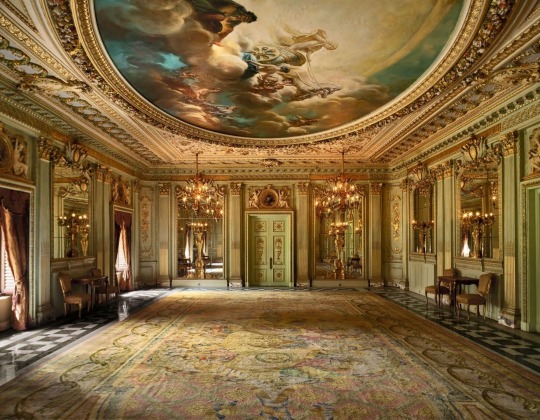
Lal Bagh Palace, Indore, Madhya Prades, India,
Restauration by Abha Narain Lambah with support from the Madhya Pradesh Department of Archaeology and the World Monuments Fund.
Photography by Talib Chitalwala
#art#design#interiors#interiordesign#palace#india#lal bagh palace#indore#madhya prades#revival#renaissance#italian#luxury homes#luxury houses#luxury lifestyle#history#style#abha narain
287 notes
·
View notes
Text
PRESERVING INDIA’s LITERARY GOLD
It’s historic. It’s iconic. It’s monumental. It’s 184 years old. It’s the jewel in the crown of literary India. It’s the legendary and the internationally renowned Town Hall, which hosts the amazing and the gigantic Asiatic Society Library. Located at South Mumbai’s famous landmark, the Horniman Circle, the Town Hall is British era’s one of the most wonderful creations gracing the skyline of Mumbai.

This heritage Victorian era structure catches your eye and imagination with its majestic stone architecture on the outside that is heavily influenced by the Greek and Roman style of construction. Designed by Col. Thomas Cowper of Bombay Engineers, this 200 feet across and 100 feet high Town Hall having a portico of eight Doric columns perched atop 30 steps of staircase; even today remains unparalleled in Mumbai’s engineering and architecture history.
With time taking its toll over the years, this magnificent edifice had fallen prey to leakages, breakages, rust and rot. Being a Grade 1 heritage structure, the state government decided to restore its old glory, and towards this end released Rs. 8.5 crore in two phases. The Public Works Department, under the aegis of one of India’s leading conservation architect Abha Narain Lambah, carried out the repair and restoration work. After 12 months of painstaking restoration work, the renovated Asiatic Library was once again thrown open to public on Sunday, 26th February.
In today’s day and age when the concept of reading rooms and libraries is fast fading into oblivion, the Asiatic Library is a ray of hope cutting across the darkness of ignorance and apathy which threatens to destroy India’s rich and multi-dimensional literary legacy. Within its tranquil and peaceful environs, the Asiatic Library stores a mammoth collection of books, periodicals, ancient manuscripts, painted folios, coins, artefacts maps and prints.

The Asiatic Library, one of Mumbai’s oldest free-for-all reading facility, is the host to over 3,00,000 books. Priceless artefacts, ancient manuscripts in Persian, Sanskrit, Urdu and Prakrit languages, over 1000 maps some of which dating back to 100 years, the Library is custodian to plethora of such rare and bibliographical treasures.
There is also a museum which holds the collection of primordial coins including a gold coin of Kumaragupta 1, a gold Mohur of Akbar, the great Mughal emperor, and coins from the Chhatrapati Shivaji Maharaj’s era.
A popular tourist hot-spot because of its colonial roots, the imperial look, and the kind of vast and varied literature treasure that it holds, Asiatic Library’s mission, objective and purpose is to inspire research and preserve the age-old literature, sciences and oriental arts which are now considered rare and antique.
As the guardian of the treasure chest of India’s archaic knowledge, the onus of maintenance and preservation of its golden and priceless possessions lies with the administration of Asiatic Library. Though 184 years old, it was only in 1991 that the Library got its first ever conservation and restoration lab, thanks to the initiative taken by Sir Dorabji Tata Trust. Asked why the Society took so much time to start the Laboratory, Asiatic Library’s President and retired IAS officer Shri S. G. Kale said, “Somebody has to give us the money. Where is the money with us? Government of India is not giving us grant which is good enough even to pay the staff salaries. These are paid from the revenue of the Library. The preservation work is entirely carried out with the help of donations. People are ready to give us money for a project, for capital expenditure. Not for revenue expenditure.”
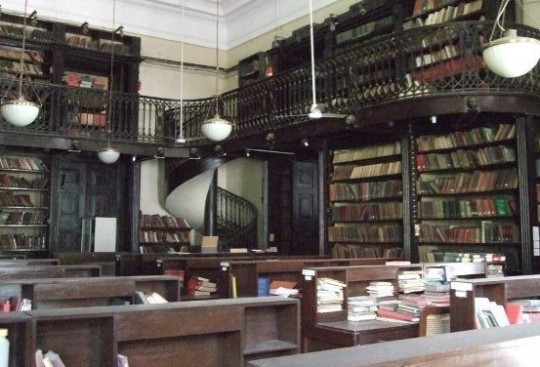
Currently the library survives on a small annual grant of Rs. 10 Lac from the Bombay Municipal Corporation (BMC). It had been raised to Rs. 25 Lac but now again it has been rolled back to Rs. 10 Lac. The Library has some corpus fund, the interest of which is used for staff, revenue activities, paying telephone bills, electricity bills. National Archives of India too has approved some grant to the Asiatic Library for microfilming the books.
“In 2015, the Government of Maharashtra had given the Library 5 Crores for digitisation of books,” says Shri Kale. “Under that grant we have digitised around 23000 books which are free from copyright. We have newspapers dating back to 1801. We are microfilming them and also digitising them. The idea is to put these up on a web portal where the world can access it. Downloading is not possible for obvious reasons. The web portal is a work-in-progress and will be launched in the near future.” The portal will not be a free-for all. The life-members of the Society would be charged lesser than an outsider who will have to pay some registration charge to view the portal.
The conservation process of the Library is divided into three parts. All those books which very old and in dilapidated condition are sent for restoration in the laboratory. There each page of the book is put through chemical and other processes and made readable enough. They are then bounded and given fresh new look. The second is digitisation. Those books which are free from copyright and in condition good enough to be digitised are sent to the digitisation department. These books will eventually find their place in the upcoming portal. While about 200 books pass through process of restoration in a year, the Library has so far digitised 23000 books. Microfilming is the third part. Microfilming is done for something as big as newspapers. Then it is stored in microfilm rolls. These rolls require special storage like fire-proof cupboards which the Library purchased a few years back.
The Rotary Club of Bombay has been of tremendous help to Asiatic Library. The Urban Renewal Heritage Committee of the Club donated Rs. 25 Lac towards setting up of a new wing of the conservation laboratory. This new wing will enhance the restoration capacity of the laboratory from the present 100 books per year to 200 books per year. Besides this, the Club has donated funds to restore 100 books, to purchase map storage cabinets, and put up Chandeliers in the Central Library Hall.
The technology currently being used for conservation, restoration and preservation of books is the same as the one used in the Department of Archives, says Shri. Kale. “Our laboratory follows internationally approved procedure of conservation and restoration. We have got an expert in our committee which has certified that the procedure that we are following is in accordance with the standard norms of International Federation of Libraries. There is an internal as well as external quality control in place.”
To run a 184 year old institution, to carry out restoration and conservation of books which are rare and age-old masterpieces on a daily basis is no less than a herculean task. Nevertheless, the staff of the Asiatic Library has been performing this difficult duty steadfastly and diligently for over 25 years now and hopes to continue doing the same in years to come promising the researchers and avid readers to keep India’s literary gold glittering for many more years to come.
2017 - FEELINGS - VADODARA
#Mumbai#Asiatic Library#Asiatic Library Mumbai#Asiatic Library Mumbai India#Town Hall#Town Hall Mumbai#Town Hall Mumbai India#Col. Thomas Cowper of Bombay Engineers#Greek and Roman style of construction#Mumbai heritage building#Mumbai heritage architecture#Mumbai heritage library#Bombay Municiple Corporation#BMC#Mumbai Municipal Corporation#Abha Narain Lambah#ANL associates
1 note
·
View note
Photo

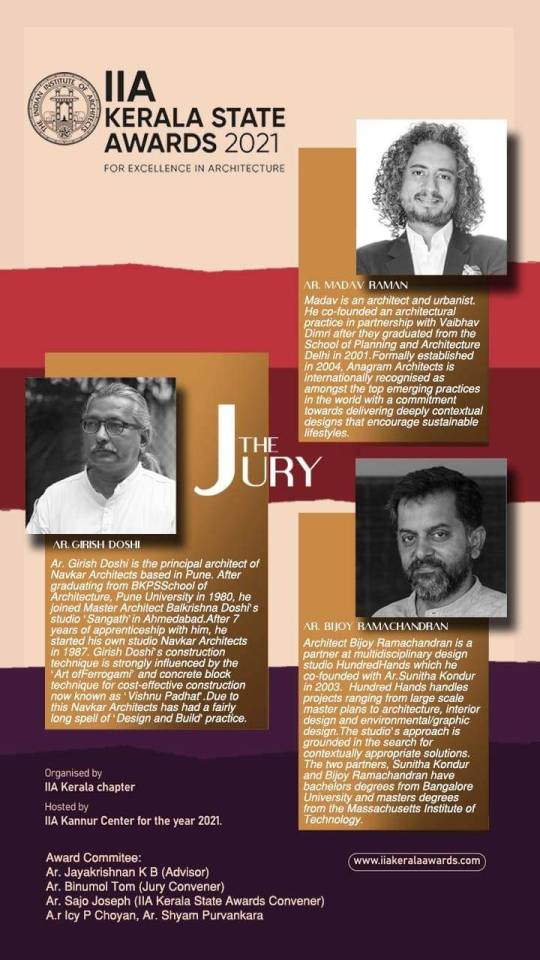
Invited to be on the jury for the IIA Kerala State Awards.
Other jurors include Girish Doshi, Abha Narain Lambah, Madhav Raman, Biju Kuriakose and Anand Wadwekar.
1 note
·
View note
Text
Three Graduation Courses That Provide Great Job Opportunities
Graduation is the conferring of an academic degree attained by thorough efforts for a certain number of years after you finish your 12th or HSC education. While going through a graduation course, students get a chance to acquire skills that make them a professional.
It helps them create opportunities for themselves and get a chance to work with the best organizations after finishing the course. When a student chooses a graduation course after finishing the 12th standard, one of the deciding factors is the probability of him or her getting good employment opportunities later.
Here are the three courses that will give you great job opportunities:
BSc Biotechnology
Biotechnology is quite crucial to modern scientific research. BSc Biotechnology course teaches you the application of biology and techniques to come up with products that could be helpful to humans.
The medical industry is only growing with time and has a bright future ahead. You can get job roles like Lab Technician, Microbiologist, Product Strategist, Epidemiologist, Biotechnology Technician, Bioproduction Specialist and Research and Development Scientist after finishing the course.
Top pharmaceutical companies like Hindustan Antibiotics, Biocon India Ltd., Ranbaxy, Dr. Reddy’s and Mankind Pharma hire students of BSc Biotechnology.
BTech Mechanical Engineering
Over the years, Engineering is considered a respected profession in the Indian society. Mechanical is one of the most popular branches among engineering courses.
The popularity is mainly because of the job opportunities available for BTech Mechanical Engineering graduates in both the public and private sectors. You can get job roles in Research and Development, Installation, Maintenance, Analysis and Testing, Design Production and many others.
Top Indian organizations like Infosys, Coal India Limited, Tata Motors, Maruti Suzuki, BHEL hire BTech Mechanical Engineering students on a regular basis.
BArch
Bachelors of Architecture is another course that you can look at if you want to have good job opportunities in the future. The jobs you get after the course pay you well, the profession is well-respected and also gives you a chance to display your creativity.
Indian Government hires BArch graduates in Archaeological Department, Railways, Housing and Urban Development Corporation and a few more government set-ups.
In the private sector, real estate companies like DLF, L&T along with Architecture firms like Abha Narain Lambah Associates, Abhimanyu Dalal Architects, AECOM and Aishwarya Tipnis Architects hire BArch graduates.
Conclusion
While selecting a course, your priority should be what interests you the most. The job that excites you and also pays you well is the one that you should choose. If you see yourself working in the pharmaceutical sector, you should choose BSc Biotechnology.
If designing machines, engines and devices attract you, then BTech Mechanical Engineering is the course you should apply for.
However, if working for real-estate companies, designing buildings and structures fascinates you, then BArch is the right course for you.
0 notes
Link
The Maharaja of Gondal, Shri Vikramsinhji, bought the Opera House in 1952. His son, Shri Jyotendrasinhji, commissioned its restoration in 2010 under the leadership of conservation architect Abha Narain Lambah. The Royal Opera House Mumbai was included on the 2012 World Monuments Watch to raise awareness about its history and significance, and support preservation efforts.
0 notes
Link
Structural and conservation expert Chetan Raikar, architect Vikas Dilawari and conservationist Abha Narain Lambah will conduct a fresh assessment and ..
0 notes
Text
New Post has been published on Titos London
#Blog New Post has been published on http://www.titoslondon.co.uk/fila-launches-the-culture-project-with-fashion-designers-and-more/
Fila launches The Culture Project with fashion designers and more
1/4
Athleisure’s gleaming role in our everyday lives is evident to all. While they may be divided by profession, millennials are united by the lifestyle athleisure purports, and sportswear brands are tapping in on that. Fila’s support for athletes par excellence like Adriano Panatta, Paolo Bertolucci and Bj��rn Borg is well known. Communicating the brand’s journey from that to a newer, younger audience requires storytelling from a new perspective.
Who better to translate that than young influencers and designers who have made a cross vocational impact on the youth culture? To celebrate Fila’s Iconic collection, and to bring it closer to the new consumers, the brand has launched ‘The Culture Project’. The initiative comprises the likes of designers Sanjay Garg, Ruchika Sachdeva, Nimish Shah, Sanchita Ajjampur, Arjun Saluja, Abhishek Paatni, conservational architect Abha Narain Lambah, musical duo Parekh & Singh, producer, screenwriter and director Kiran Rao and photographer Ashish Shah, who have been roped in for the project. The list also includes notable names from the art and design world such as Aman Khanna, Shiva Nallaperumal, Daksha Salam, journalist Chinki Sinha and tennis player Rian Pandole. Their combined narrative has resulted in illustrations, art pieces and fashion experiments that come together under The Culture Project that has been curated by Kshitij Kankaria.
Ruchika Sachdeva of Bodice spoke about how getting out of her comfort zone was a learning experience. “It was creatively liberating to merge sensibilities with such a paradoxical yet iconic brand. Such collaborations always make me grow as a designer,” she said. Meanwhile Sanjay Garg, best known for his love for handloom saris, spoke about clash of two seemingly opposite aesthetics and the brainchild born from it. “I like to think that my garments are fundamental classics. Take my saris for instance, that I have tried to make more accessible and appealing to a larger audience. Given the pluralism of this generation, I love how a traditional handloom can be paired with a sporty logo tee and still work.”
Scroll through the slideshow for a closer look at The Culture Project by Fila.
The post Fila launches The Culture Project with fashion designers and more appeared first on VOGUE India.
0 notes
Text
THE CRUSADER OF ARCHITECTURAL HERITAGE
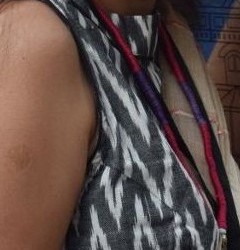
Meet Kruti Garg, a conservation architect by profession and a die-hard heritage lover at heart. Young and dynamic, Kruti is Director of Conservation at the renowned architectural restoration firm Abha Narain Lambah Associates (ANL), Mumbai.
For the past 11 years, Kruti has executed several projects in Mumbai and across India which has given a new lease of life to the heritage structures. Forming part of the long list are the likes of Royal Opera House, Town Hall, Prince of Wales Museum and Bombay Municipal Corporation (BMC) building in Mumbai, Jai Vilas Palace Museum in Gwalior, Bharatpur Museum in Rajasthan etc. Currently Kruti is busy working on five projects in Rajasthan, the Bombay High Court in Mumbai, the Teen Murti House and Bikaner House in Delhi, and a few more projects in Punjab.
While restoring and conserving the heritage glories of India is her full time job, there is one thing that Kruti does which distinguishes her from the contemporaries in this field, and puts Kruti in the special league of conservation architects.
Kruti is the crusader of creating awareness among common people about the significance and the need of protecting India’s architectural heritage. She believes that “heritage is part of the people and people are part of heritage”, and it is therefore necessary to make them feel one with the heritage.
Excerpts from the interview.
Tell us about yourself and your work.
I am a Conservation Architect with Masters in Architectural Conservation from the School of Planning and Architecture, Delhi. I have been involved in the field of heritage conservation since past 11 years and have worked on a range of projects the latest being restoration of Mumbai’s Royal Opera House and Asiatic Society. In pursuance of my passion for heritage, I have been closely associated with the Kala Ghoda Association since 2010, heading the Heritage Walks section for the annual Kala Ghoda festival. I have choreographed many heritage walks at the festival which are informative and fun at the same time. This year I designed a first of its kind interactive installation dedicated to the heritage of Mumbai city when it became a visual medium of interaction for the visitors through art.
Conservation architecture is not everyone’s cup of tea. How did you get attracted to this field?
Although I was always interested in history and old architecture, a rendezvous with altered, restored and adapted space, the story of reviving a dying fort by breathing a new use to it and ensuring its character spoke the same language touched me so much that I knew this is what I want to do. To me, architecture not only teaches you how to create buildings or spaces; it also lays down the foundations of exploring and making your own design principles. Applying these principles in the realm where future and past collide allowed me to explore freedom of creativity, technical expertise in the uniqueness of breathing life into old buildings and creating spatially conducive environments well integrated and infused with the historic character of the building to enhance its architectural quality, retain its integrity and increase its lifespan.

How is being a conservation architect different from being an ordinary architect ? Obviously the basics remain the same, but isn’t conserving and restoring heritage sites quite different from simply constructing a building?
A conservation architect by education is someone who has achieved a Masters degree in the field of Architectural Conservation after having completed B.Arch, which allows you to develop specific skills in assessment, interpretation, management, formulation of policy, and documentation of culturally significant places including buildings, sites and cultural landscapes. It sometimes is more challenging to deal with an existing building or space which has been envisioned by its creator and has undergone changes since. As a conservation architect you should be able to combine expertise in technical and aesthetic principles of architecture along with material integrity and authenticity to impart or retain the character of the space which is iconic to its identity.
Where does India stand in comparison to other countries with heritage wealth? Are we a country with maximum heritage wealth ?
While India stands 7th in the world amongst the countries having the maximum number of world heritage sites, I personally believe as a nation we have a lot more than just a few listed world heritage examples which not only give an insight into the history and the traditions of our past embedded in the built forms, but also have been testimony to the rich and varied cultural heritage of our country.
What is your opinion about the heritage conservation efforts put in by the government? Are they good enough?
Although we can always ask for a little more, the Government is taking increased initiative towards the conservation of the built heritage in our city and this increased awareness has been beneficial towards setting standards and policies for the restoration of our heritage.
You have been the curator of Heritage Walks at the globally renowned Kala Ghoda Arts Festival. What is your objective behind these Heritage Walks?
Creating awareness towards our heritage, engaging people with their heritage to me is as important as it is to work in the field of conservation, which is why I have been associated as a curator and heading the Heritage Walks section of Kala Ghoda since 2010. These walks have been the forerunner in creating new and varied and interesting interactions highlighting the history and story of Mumbai through a magnifying lens delving into details and aspects making them more interactive and experiential. I have choreographed the walks, wherein we cater to a selected number of audiences. The idea is to reach out to a larger section of the society and this was achieved by merging two arms of culture – art and heritage through an interactive installation.
What does ‘choreographing the Heritage Walks’ mean ?
Choreographing would basically mean designing the flow of the heritage walk which includes the topic of expertise in that walk, the route and the narrative based on the theme of the walk. E. g. I have designed walks like food history and Irani cafe's, walk highlighting the role of freedom movement in Mumbai, walk though the historic market areas, heritage cycle rides, etc.
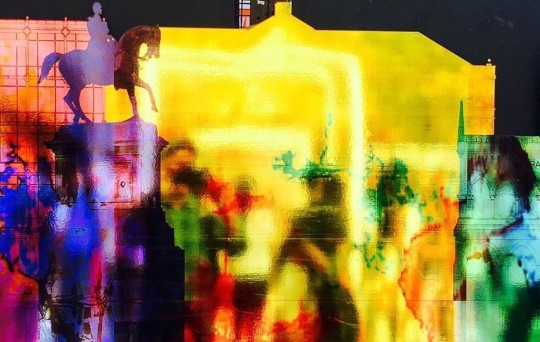
What was the interactive installation that you put up this year at the Kala Ghoda Art Festival all about?
My art installation, which was titled ‘Inner Reflections’ and put up at the Kala Ghoda Arts Festival, literally placed the visitor in a silhouette of heritage buildings in a reflective medium across the city reinforcing its very ideation that "You belong to your heritage as much as it belongs to you". The installation was all along Rampart Row (the road in South Mumbai on which Kala Ghoda Festival is held) along the art stands which are fixed there. There were 28 panels which were part of the installation mounted on these each of which was nearly 10' long and 4' in height. Each panel depicted a style and harmony in architectural language, e.g. there were two Art Deco panels and then Victorian Gothic panel depicting Victoria Terminus a.k.a. Chhatrapati Shivaji Terminus (CST) and the BMC building.
Why you feel the need to involve common people in heritage conservation?
About 20 years back, heritage was merely understood as monuments where one visits as a tourist, interacts with the space momentarily and forgets about it... We almost always neglected that "We the People" engage with heritage in many ways and have always been a part of its existence, sometimes being a part of its functioning and going there every day, sometimes passing by, sometimes living in it, sometimes through stories and sometimes just being around it. But surprisingly, it has failed to develop a connect or a feeling towards our heritage therefore alienating us from our spaces and places reinforcing a barrier with our heritage. This is why I feel that we can protect our heritage only if we feel for it and connect with it.
To what extent do you think your unique initiative has been successful in creating awareness about heritage preservation and conservation among common people?
Participants and visitors do show their interest in the conservation of structures and being from the field it enriches their experience not only by knowing the history but also by understanding the technical details, the process of restoration and the stakeholders involved, which gives out a message that the efforts to conserve these structures stem from us as citizens. After all, when there is awareness and when one strikes a connect with history, it does make a difference in one’s approach towards heritage whether intangible or intangible.
How did the visitors at Kala Ghoda Festival react to your installation?
Since it was a reflective installation, people interacted with it differently. Some tried to recognise the building, some would try to locate these buildings in the city and surroundings, and almost everyone stopped and clicked a selfie at this point with their own reflection.
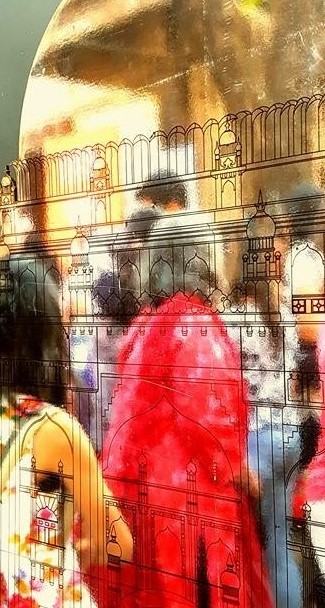
You believe that heritage is a part of the people and people are part of the heritage. Please explain.
Just like how the city is in constant motion against the backdrop of the heritage buildings standing tall with people coming and going, my installation depicted the same motion which changes with every frame and the visitors become a part of it. As one walked along the Rampart Row, the installation of artistically juxtaposed cityscape of Heritage buildings in Mumbai reflected the symbiotic relation of the citizens with their city. The installation aimed to celebrate "you" who became an integral part of the installation reflecting exuberance, vibrancy, dynamism and mobility... all of which signifies the essence of Mumbai.
Your views on importance of protecting, conserving our heritage.
We strive for a better environment within our homes, we have an immediate connect with our roots and traditions on an individual level. If we extend our sensitivities towards our cities as our homes, towards our roots which are tangible forms right in front of us as our cultural heritage, we can symbolize that development and conservation are two sides of the same coin and the heritage buildings can greatly benefit and impart a sense of identity in a mutually respectable way.
0 notes